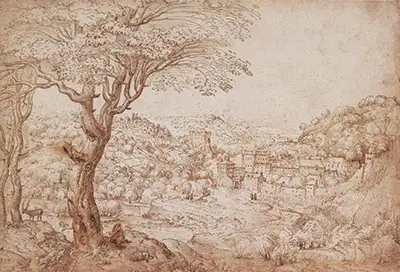 Buy Art Prints Now
Buy Art Prints Nowfrom Amazon
* As an Amazon Associate, and partner with Google Adsense and Ezoic, I earn from qualifying purchases.
Landscape with Saint Jerome features the standard layout of many landscape drawings from Pieter Bruegel the Elder, with one large dominant item in the foreground, with the remaining countryside sweeping across behind.
It is only when we look very closely at a high quality reproduction of this drawing can we make out some of the finer details that lie within it. The tree nearest us stands proud on the left hand side, with its branches reaching up to the top of the design. Darker touches are added here to ensure it first captures our attention, and also to underline its proximity to us. In contrast, the background is much lighter, giving that feeling of distance. Multiple hills can be seen, covered in bushes and trees right across. The sky is typically devoid of much detail so as to avoid stealing any of the attention from the more important elements. Bruegel was a master of these sweeping landscapes scenes at a time when Europe was still to truly accept this genre, particularly from the point of view of art academics within both the Northern and the Italian Renaissance.
If we study the likes of Bacchus and Ariadne and Christ and Mary Magdalene (Noli me tangere) by Titian or Elevation of the Cross by Rubens, for example, we can see that very clearly that figurative art was dominant, and that landscape skills were still being seen as something that could support an artwork rather than being the key part of it. Bosch and Bruegel would not agree with this viewpoint, as shown in their oeuvre, and in later centuries it would become accepted to specialise entirely in this genre. It would be Claude Lorrain, then Turner and Constable and then finally the Impressionists who would finally finish off the advancements made by the likes of Bruegel and other members of his own family. Those learning about art history for the first time today maybe entirely unaware of this process and perhaps just assumed that landscape has always enjoyed the prominence that it holds today.
This drawing was gifted from the Ailsa Mellon Bruce Fund to the National Gallery of Art in the USA. They have an exciting and varied collection which covers European art but also American as well. Drawings are a key part of this offering, due to several very generous bequeths and a good number of Albrecht Durer drawings can be found here, for example. You may also like something more recent such as The Farm by Joan Miro or The Boating Party by Mary Cassatt. In all, much to see, far too much to include here. All tastes are catered for, with a good number of antiquities from a variety of different cultures and civilisations also on display all year round.




